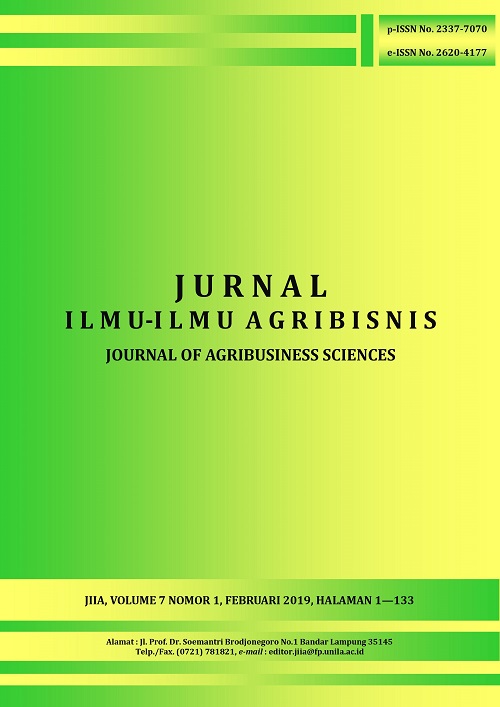ANALISIS EFISIENSI PRODUKSI USAHATANI UBI KAYU DI KECAMATAN NATAR KABUPATEN LAMPUNG SELATAN
DOI:
https://doi.org/10.23960/jiia.v7i1.3327 Abstract View: 1932
Abstract View: 1932
Abstract
This study aims to analyze the profitability, factors that affect production and production efficiency of cassava farming. The research is conducted by survey method in Natar District of South Lampung Regency from June to August 2017. The 56 research samples are obtained by simple random sampling method. Primary data is obtained from direct questionnaires interview with cassava farmers and secondary data obtained from several related institutions. Data is analyzed qualitatively and quantitatively by income analysis and production function of Cobb Douglas. The results showed that cassava farming in Natar District of South Lampung Regency was profitable for farmers of Cassesart variety and not profitable for other varieties. Factors affecting cassava farming for respondents of Cassesart variety were land area, urea fertilizer and labor, for respondents of other varieties were land area and labor. Production process was not efficient and in increasing return to scale phase.
Key words: cassava, efficiency, production, profit
Downloads
Downloads
Published
How to Cite
Issue
Section
License
Authors who publish with this journal agree to the following terms:
Authors retain copyright and grant the journal right of first publication with the work simultaneously licensed under a Creative Commons Attribution License that allows others to share the work with an acknowledgement of the work's authorship and initial publication in this journal.
Authors are able to enter into separate, additional contractual arrangements for the non-exclusive distribution of the journal's published version of the work (e.g., post it to an institutional repository or publish it in a book), with an acknowledgement of its initial publication in this journal.
Authors are permitted and encouraged to post their work online (e.g., in institutional repositories or on their website) prior to and during the submission process, as it can lead to productive exchanges, as well as earlier and greater citation of published work (See The Effect of Open Access).














